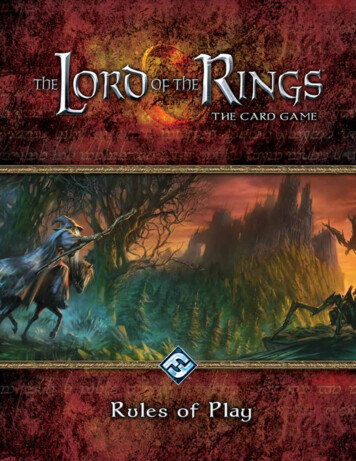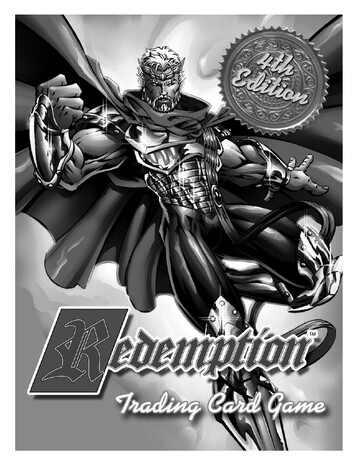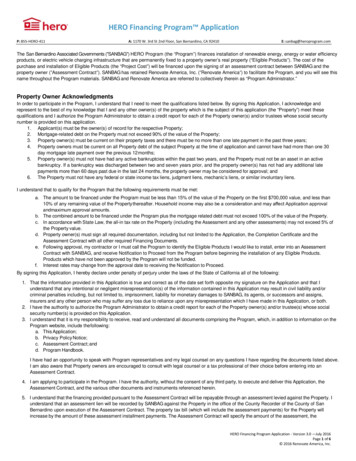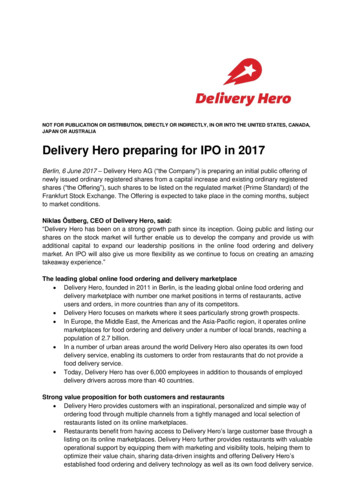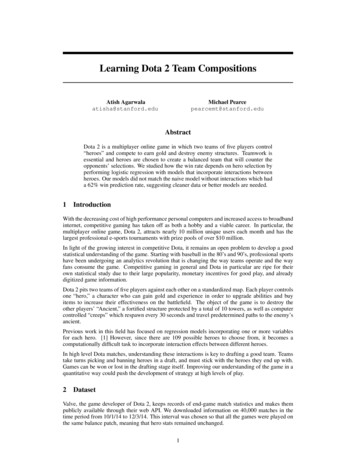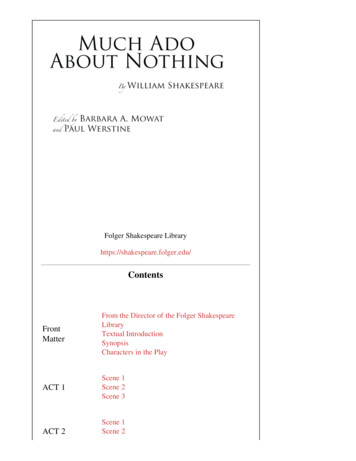
Transcription
HERO Program ProfileFinal ReportCALMAC ID: PGE0388.01October 3, 2016Pacific Gas and Electric Company, San Diego Gas & Electric,Southern California Edison, and Southern California Gas Company
This page left blank.
Prepared by:Karen HorkitzPat McGuckinLaura JamesChristopher FryeHugh RatcliffeCadmus Energy Services
This page left blank.
Table of ContentsExecutive Summary.1Key Findings . 1Contractor Network . 2Marketing. 2Key Benefits for Customers . 2Typical Projects . 3Typical Participants . 4Satisfaction . 5Gaps in the Market for Energy Efficiency Financing . 5Key Conclusions . 5Key Recommendations for the Residential Energy Efficiency Loan Assistance Program (REEL) . 7Introduction . 10Project Purpose and Scope. 11HERO Background. 11Researchable Questions . 12Research Activities . 13Local Government Interviews. 13Renovate America Interviews . 14Contractor Interviews. 14HERO Marketing Review . 15Residential Survey . 16Findings of the HERO Program Profile Study . 17Program Structure and Process . 17Program Structure. 17How HERO Works . 19Eligible Products . 20Quality Assurance and Oversight . 20HERO Marketing Strategy . 21Marketing Roles . 21Marketing Materials . 23
HERO Website . 23Messaging . 29Program Partner Experience . 29Local Governments . 30Contractors. 33Customer Experience . 37Typical Projects and Participants . 39Benefits to Customers . 45Participant Satisfaction . 49Limitations of HERO . 52Market for Energy Financing . 55Growing Market for PACE . 55PACE Marketplace. 56Other Financing. 59Common Methods of Payment . 60Rebates and Financing . 62Barriers to Replication or Expansion . 63Conclusions . 65Driving Energy Efficiency Upgrades . 65Lessons Learned for Program Design . 66Recommendations for the Residential Energy Efficiency Loan Assistance Program . 70Target Market . 70Program Design . 71Recruiting and Marketing . 72Appendix A. Policy Considerations for Residential PACE . 74Appendix B. Survey Instrument . 76Appendix C. Marketing Collateral . 93ii
Executive SummaryIn 2013, the California Public Utility Commission (CPUC) issued an order that the California investorowned utilities (IOUs), in collaboration with the California Alternative Energy and AdvancedTransportation Financing Authority (CAEATFA) and other state and regional agencies, offer coordinated,statewide financing programs to support energy efficiency improvement projects in residential,multifamily, and commercial markets. The first of these financing pilots, the Residential Energy EfficiencyLoan Assistance Program (REEL), launched in the spring of 2016.Since 2013, a property-assessed clean energy (PACE) financing program for single-family homeowners,known as HERO (formerly the Home Energy Renovation Opportunity Program) and beginning in westernRiverside County, has expanded to cover most of the state of California. HERO loans have funded over 1.6 billion in energy and water conservation improvements to single-family homes. The IOUscommissioned this study to provide insight into the factors that are driving the HERO Program to suchrapid growth and the program’s impact on homeowners' decision-making process and installation ofenergy efficiency improvements. The study also assessed potential gaps in the market for residentialenergy efficiency financing that are not addressed by HERO. The study’s findings will inform the IOUsefforts to support the REEL financing pilot and incorporate it as an offering in its energy efficiencyportfolio programs.This report evaluates these aspects of the HERO Program: Key components of program structure and implementation in terms of program growth Objectives of HERO stakeholders and HERO Program goals and design compared to drivingenergy efficiency Characteristics of typical participants and projects funded by the HERO Program compared toIOU rebate programs and projects not influenced by any programA companion report, the HERO Program Savings Allocation Methodology Study, compares differentmethodologies for determining the relative impact of financing and IOU rebates on a homeowner’sdecision to make an upgrade.Key FindingsThe findings in this report are based on these primary data collection activities: Interviews with six local government sponsors of the HERO Program, including the WesternRiverside Council of Governments (WRCOG), the local government with primary responsibilityfor administering the program One interview with Renovate America staff Interviews with 23 participating contractors An online survey of the general population of single-family homeowners in parts of Riversideand San Bernardino counties where HERO initially launched (3,501 completed surveys)1
Contractor NetworkHERO has several hundred participating contractors who serve as the primary delivery channel tocustomers. Contractors have joined because HERO has the potential to grow their businesses by givingpeople—who previously had few payment options—a great deal of purchasing power. Participatingcontractors reported they are very satisfied with the program for a number of reasons. HERO has set ahigh bar for features that are most critical to contractors’ business, such as speed, support, flexibility,and polished marketing. Although the HERO process is not quite as fast as a credit card, customers canbe approved during sales visits. HERO provides extensive, ongoing training to contractors, and the callcenter remains available seven days a week. Contractors reported it was very easy to get a responsefrom the call center so many make it a regular practice to have a call center representative on the linewhile they present the HERO option to homeowners, even before the homeowners asks a question.Although contractors typically participate in many financing programs, they tend to present only oneoption at a time to an individual customer. Other PACE programs that compete with HERO focus onexpanding their own contractor base and convincing these contractors to offer their PACE program overHERO; however, contractors said they consider HERO the standard other programs need to meet.MarketingThe primary messages in most HERO marketing materials are that the program is fast, easy to use, andpopular with other homeowners. Messaging also emphasizes that the program is designed to achieve asocial good—conservation—and is sponsored by local governments. Contractors report HERO materialsare helpful in persuading customers to move forward and lend credibility to their own business. Theprogram offers a number of print and online marketing resources, but contractors said a three-minute,animated video that explains the program was the most helpful tool. Most contractors do not mentionHERO in their own marketing, and most customers learn about the program from the contractor duringa sales visit when they are considering a specific purchase.Key Benefits for CustomersThe HERO Program advertises that it is fast and easy, and several features of the program are designedto ensure this. Customers receive approval over the phone, while the contractor is in the home, andknow right away what they can afford. Customers can sign all documents online using an electronicsignature; there is nothing to mail and no need to visit a bank.Nevertheless, HERO is not as fast as paying cash, using a credit card, or using contractor financing.However, the HERO financing product offers two key advantages over other payment alternatives withcomparable convenience: Customers can finance up to 15% of the value of their home, depending on how much equitythey have available. This gives many customers considerably more buying power than if theyused cash, a credit card, or other unsecured financing. The assessment’s tenor can extend to 20 years, making payments for such large sumsmanageable for many customers. Although HERO interest rates and fees are high compared to2
some financing options (e.g., a home equity line of credit), they are equal to or lower than mostcredit cards and contractor financing.The combination of these features—convenience, large financing amounts, and long terms—makesHERO unique. Each feature is available through other common financing products, but few other nonPACE financing products offer both. According to a homeowner survey, other popular features of HEROare the tax deductibility of the interest portion of the assessment, which offsets some of the cost, andthe possibility of transferring the assessment when selling the home.Typical ProjectsCadmus surveyed the general population of single-family homeowners in target zip codes in Riversideand San Bernardino counties where HERO has been active longest. The survey asked about recent homeenergy upgrade projects,1 identified HERO and rebate participants, and collected data on decisionmaking factors and demographic details (The survey also found that HERO and rebate participants wereabout equally likely to install more than one item at the same time (55% and 59%, respectively), andthese two groups were more likely to install multiple items at once than were nonparticipants. Amongnonparticipants who completed a home energy upgrade project, only 34% installed more than one itemin one project.HERO participants spent far more money than rebate participants or nonparticipants. HERO projects,excluding solar PV installations, cost around 20,000 on average, twice as much as the average projectcost for rebate program participants (before accounting for any incentives). Nonparticipant projects costjust under 7,000 on average.Figure 1). The survey found that HERO and rebate participants were about equally likely to install HVACequipment, insulation, and air sealing or duct sealing. HERO participants were more likely to install newwindows than rebate participants, with about 53% of HERO projects including windows compared to31% of rebated projects. Windows were the only item that HERO participants were more likely topurchase and install than were rebate participants. However, rebate participants were more likely thanHERO participants to install water heaters and pool pumps or motors.The survey also found that HERO and rebate participants were about equally likely to install more thanone item at the same time (55% and 59%, respectively), and these two groups were more likely to installmultiple items at once than were nonparticipants. Among nonparticipants who completed a homeenergy upgrade project, only 34% installed more than one item in one project.1The survey asked respondents to consider only the following six types of equipment as a home energyupgrade: HVAC measures, insulation, windows, air or duct sealing, water heaters, or pool equipment. Weselected these as the major measures more likely to require financing and be eligible for both HERO andrebates.3
HERO participants spent far more money than rebate participants or nonparticipants. HERO projects,excluding solar PV installations, cost around 20,000 on average, twice as much as the average projectcost for rebate program participants (before accounting for any incentives). Nonparticipant projects costjust under 7,000 on average.Figure 1. Commonly Installed Improvements**Respondents who used both HERO and a rebate are included in both the HERO and rebate groups.Typical ParticipantsSurveys show that HERO penetrates a different demographic than do rebate programs. On average,HERO participants tended to track closely to the general population for income and education levels.Rebate participants tended to have much higher incomes and slightly more education than the generalpopulation. For example, 58% of rebate participants had an income of 100,000 or more, compared to38% of HERO respondents and 36% of the general population.On the other hand, the age distribution among rebate participants was close to the general population,but HERO participants tended to be younger, with 25% of HERO participants under 40 years of agecompared to 17% of rebate participants and 14% of the general population.4
SatisfactionLocal government representatives and contractors reported high satisfaction with HERO overall amongconstituents and customers; however, surveys showed that HERO participant satisfaction was morevaried. When asked to rate their satisfaction with HERO on a nine-point scale, with 1 being stronglysatisfied and 9 strongly dissatisfied,2 32% of HERO participants chose 1, 2, or 3, indicating satisfaction. Anearly equal proportion, 33%, chose 7, 8, or 9, indicating dissatisfaction. About half of HERO participantsresponded to a question asking for suggestions to improve HERO. Nineteen percent (n 36) of HEROparticipants who answered the question suggested that the program needed to be more transparentabout applicable fees and the tax deductibility of the assessment, and 15% of these respondentssuggested the program should offer a lower interest rate.Gaps in the Market for Energy Efficiency FinancingAlthough participation in HERO has grown rapidly, the program is not an appropriate option for allhomeowners. Some homeowners do not have sufficient equity in their home to be eligible for theprogram or would be denied because of recent bankruptcies or other existing liens. Some commonenergy efficiency projects may not meet the 5,000 minimum cost.HERO and PACE loans are also not equally affordable for homeowners. Retirees, self-employedhomeowners, or others who do not have a significant income tax burden cannot deduct the interestfrom their taxable income, making the financing more expensive for them than for others who can takethat deduction.In addition, because HERO and other PACE financing programs are relatively new, customer attitudescontinue to develop. Surveys indicated about 45% of homeowners who completed a project but did notuse HERO were not comfortable financing a home improvement through their property taxes. Inaddition, some HERO participants were not satisfied with their HERO experiences, many because theydid not understand the actual rates or fees they would need to pay or were disappointed to learn thattheir assessment interest was not tax deductible.Key ConclusionsFinancing is an important factor for achieving larger energy efficiency improvement projects withmultiple measures.Customer surveys indicated that homeowners who used HERO spent more than twice as much ashomeowners who only used a rebate or homeowners who did not participant in any program. Projectsthat were financed, whether through HERO or other means, were larger than projects paid for in cash,and HERO projects were larger than projects financed through other methods. This indicates that2The 1-9 scale, though unusual in most contexts, is typical for studies using the analytic hierarchy process, oneof the methodologies Cadmus reviewed as part of this study. The same scale was used for all survey questionsfor consistency.5
financing is an important factor in large investments in home energy efficiency, and HERO is a popularchoice among homeowners completing the largest energy efficiency upgrades.HERO enables high-efficiency improvements in market segments that rebates do not penetrate.Survey results indicate that the average HERO respondent was likely to be younger, less educated, andhave a lower income than the general population. Rebate participants were likely to be older, moreeducated, and have higher incomes than the general population. These results indicate that financingmay enable high-efficiency upgrades for groups that rebates have historically struggled to impact.Despite the popularity of HERO and PACE, there are still gaps in the market for residential energyefficiency financing.Although the HERO Program is making inroads, the residential market remains largely untapped.Seventy-three percent of survey respondents have not made any energy efficiency improvements in thelast three years (46% have not even considered improvements, while 27% have considered them but notacted). Only 2% of respondents have used the HERO Program. New financing programs―and the newmarketing that would accompany them―could help accelerate the adoption of residential energyefficiency improvements.Although PACE works well for many people, it does not work for all market segments. PACE may not bea suitable option for the following: Projects less than 5,000 Renters Homeowners with no equity Homeowners with recent bankruptciesPACE may be more expensive for some groups that cannot benefit from the tax deduction. For example,retirees or self-employed homeowners may not have a tax burden or may already have a substantialnumber of write-offs. Long tenors that allow low payments may still make PACE a useful alternative forthese groups, but the product is not as affordable for them over the long term as it is for others.Even among market segments that qualify for HERO, some homeowners expressed discomfort withsome aspects of the financing. Almost 50% of homeowners who completed an energy-related upgradebut who did not use HERO said they did not wish to use their house as security for financing. There isopportunity for a financing alternative to HERO that offers lower rates and fees and that addresses theinformation and confidence barriers that customers may face when considering an upgrade. There wasalso anecdotal evidence that some contractors would see a marketing benefit in a financing optionoffered through a utility program. For example, two contractors said they were very interested in utilitysponsored financing options because they believed the utility brand would lend additional credibility totheir proposals.Meeting contractor needs is the key to delivering energy efficiency financing.6
As demonstrated by the three PACE programs administered by third-parties and most active in California(HERO, California FIRST, and Ygrene), the key to driving participation in a financing program is to meetthe needs of contractors. All three programs have dedicated significant resources to providing an easyand reliable tool that can help contractors grow their businesses. As a result, all three programs haveseen rapid expansion and growth in participation. There is good reason for this focus on contractors;they are in the advantageous position of working face-to-face with homeowners at the point of sale andare therefore well-positioned to influence the customer’s decision. Contractors recognize that financingcan be a crucial tool to overcoming cost objections and closing sales, and they typically choose to havemultiple financing products available to offer customers. However, contractors will only promote thefinancing product that is both most likely to close the sale and requires the least amount of work ontheir part.To succeed, a financing product must be easy for contractors to integrate into their sales process andbusiness operations, achieving the following: Port seamlessly into their proposals Offer customers a compelling proposition Accept a broad array of eligible measures Approve the majority of customers Confirm approval quickly while the contractor is “at the kitchen table” Support fast and easy closings Pay the contractor promptlyEffective product and sales training is also important, as is readily available support when needed. HEROhas now set a high standard for meeting each of these criteria from a contractor perspective.Program flexibility is crucial for contractor and customer appeal.PACE financing offers a broad tool that can help achieve a variety of goals. Though the program’s energyand water conservation elements offer two important benefits, WRCOG sponsored HERO primarily toachieve economic goals. Such goals appear to carry fewer policy requirements than conservation goals,and the absence of ratepayer or significant taxpayer subsidies avoids the need for extensive regulatoryoversight on spending or program outcomes. As a result, HERO has been able to offer a simpleapplication process and minimal restrictions on eligible measures, which have been key factors in itsgrowth. (In contrast, when the SCEIP PACE program sought to enforce a policy-driven project loadingorder, requiring efficiency measures before renewables, participation dropped sharply.)Key Recommendations for the Residential Energy Efficiency Loan AssistanceProgram (REEL)Promote REEL’s ability to serve market segments that HERO does not serve.7
Not all homeowners are able to―or want to―use the HERO Program. CAEATFA and the IOUs shouldtake steps to make sure that these customers are aware of REEL, thereby encouraging them to makehigh-efficiency choices that might not be made otherwise. REEL can create this awareness throughcontractors at the point of sale and through IOUs’ existing communications with customers. Segmentsthat the HERO Program does not serve include: Projects under 5,000. These smaller purchases still represent a major expenditure for manyhomeowners, especially those facing the unexpected expense of replacing failed equipment.Customer surveys showed that the average price for standard-efficiency projects was below 5,000, and good financing could help customers who might otherwise buy the cheapestavailable option. This market segment, and the contractors who work in this segment, may beworth special attention. Homeowners who want to―or need to―finance non-eligible measures along with eligiblemeasures. With REEL, up to 30% of the loan can be for non-eligible measures, whereas HEROrequires that all measures are eligible. Non-eligible measures are sometimes a necessary part ofan energy improvement project, especially in older homes. For instance, a home with aluminumwiring should replace it with copper wiring before installing new electrical measures. Homeowners who want a lower interest rate or lower fees, to the extent that REEL lendersoffer lower rates and fees. Homeowners with less than 10% equity in their home. REEL loans are not secured by aninterest in the property, so equity is not a requirement. Homeowners with a late property tax payment in the last three years. Depending on thecircumstances, these homeowners may still be creditworthy borrowers. Homeowners in communities not served by HERO. The HERO Program is available in most ofCalifornia (more than 340 cities), but more than 130 cities are not yet served. Although not all ofthese 130 or more cities are in REEL territory, and many of them are expected to authorize theHERO Program, REEL should track which cities in its territory remain unserved. Homeowners who may prefer more traditional financing that does not involve repayment viaproperty taxes, does not place a lien on their home, and does not raise questions upon resale orrefinance.REEL needs to offer speed and convenience that is comparable to HERO, unless REEL can offer othersignificant benefits to contractors relative to what HERO offers.Contractors and customers reported that the convenience of HERO was a key feature in their decision touse the program. Contractors said that they now expect comparable levels of service in other financingprograms. Therefore, to ensure that contractors not only participate in REEL, but also promote REEL toas many customers as possible, it will be important for REEL to offer features such as rapid approvals, alarge and specialized call center, online application and closing processes, contractor proposal tools andproject tracking software, and payment within seven days.8
If REEL can offer features that HERO does not, this may compensate for some lack of speed orconvenience in terms of processing but only if it is a feature that is useful to the contractor. Allowing30% of funds to cover no
HERO Program Profile Final Report CALMAC ID: PGE0388.01 October 3, 2016 . Riverside County, has expanded to cover most of the state of California. HERO loans have funded over . and San Bernardino counties where HERO initially launched (3,501 completed surveys) 2

